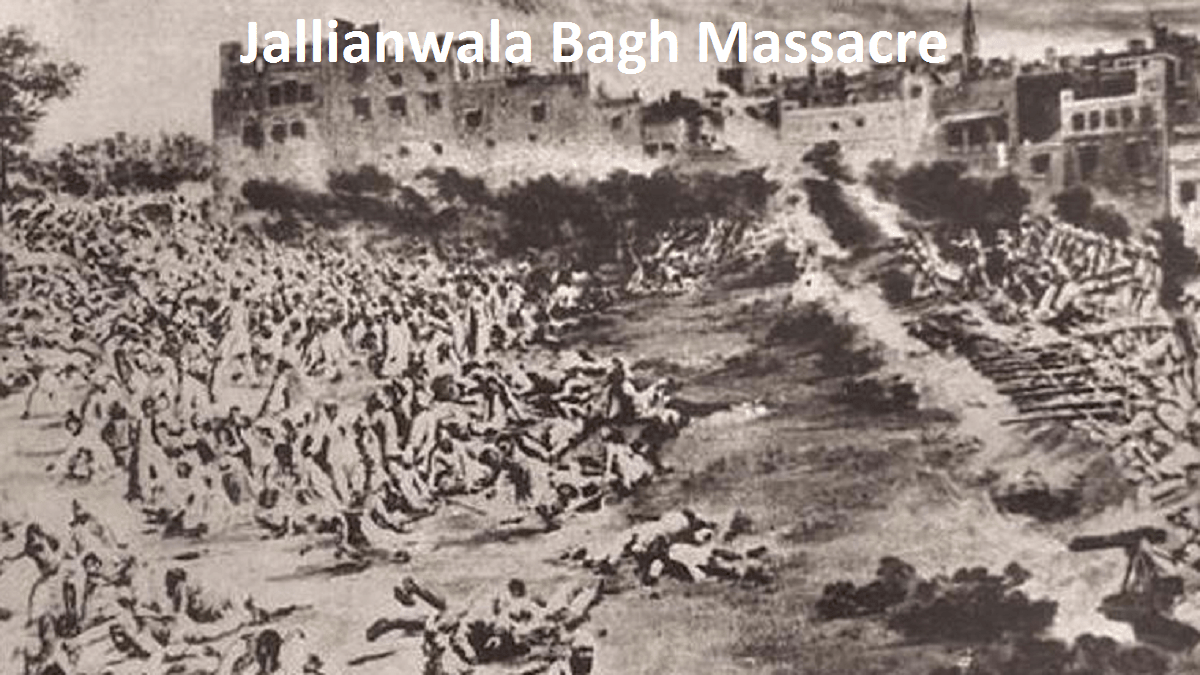Jallianwala Bagh Massacre: The Jallianwala Bagh Massacre, also known as Amritsar Massacre, was an incident that took place on 13 April 1919. On that day, British troops fired on a large crowd of unarmed Indians in an open space called Jallianwala Bagh. in Amritsar, in the Punjab region (now in the state of Punjab) of India. Several hundred people, including children, were killed and hundreds more injured. This incident is a turning point in modern Indian history that led to Gandhi’s full commitment to the cause of Indian nationalism and independence from Britain. The incident undoubtedly left a permanent scar on Indo-British relations.
This massacre exposed the inhumane approach of the British when British troops opened fire in cold blood on an unarmed crowd without warning from General Dyer, who had gathered in the closed park for the public gathering that was prohibited.
READ| When and why did the British first land in Indian territory?
About the Jallianwala Bagh massacre
On April 13, 1919, people gathered at Jallianwala Bagh (Amritsar) to protest against the arrest of the two nationalist leaders, Satya Pal and Dr. Saifuddin Kitchlew. Suddenly, a British military officer, General Dyer, entered the park with his troops. Without even warning the people to disperse, he ordered his troops to fire on the unarmed crowd for ten minutes and when they ran out of ammunition, they left. In those ten minutes, according to congressional estimates, about a thousand people died and about 2,000 were injured. Bullet marks can still be seen on the walls of the Jallianwala Bagh, which is now a national monument.
The massacre had been a calculated act and Dyer proudly declared that he had done it to produce a “moral effect” on the people and that he had decided that he would shoot all the men if they were to continue meeting. He didn’t regret it. He went to England and some English people raised money to honor him. Others were shocked by this act of brutality and demanded an investigation. A British newspaper called it one of the bloodiest massacres in modern history.
Some 21 years later, on March 13, 1940, Udham Singh, an Indian revolutionary, shot dead Michael O’Dwyer, who was the lieutenant governor of Punjab at the time of the Jalliawala Bagh massacre. The massacre aroused the fury of the Indian people and the government responded with more brutality. The people of Punjab were forced to crawl through the streets. They were put in open cages and whipped. Newspapers were banned and their editors imprisoned or deported. A reign of terror was unleashed, like the one that followed the suppression of the 1857 revolt.
Solve| GK Q&A on Dr BR Ambedkar
How many people died in the Jallianwala Bagh massacre?
There was no official data on the number of deaths during the Jallianwala Bagh massacre. But the official investigation by the British revealed that there were 379 deaths and Congress cited that more than 1,000 people died in the massacre.
Rabindranath Tagore, who had been knighted by the British, renounced his knighthood. In his letter to the viceroy, he declared: “The time has come when the badges of honor make evident our shame in their incongruous context of humiliation and I, for my part, wish to divest myself of all special distinctions, alongside those of my compatriots, who, due to their supposed insignificance, are exposed to suffering a degradation not suitable for human beings.” The massacre marked a turning point in the history of the fight for freedom.
In December 1919, the Congress session was held in Amritsar. A large number of people attended, including farmers. It was clear that the brutalities had only added fuel to the fire and strengthened the determination of the people to fight for their freedom and against oppression.
Jallianwala Bagh Massacre: All Related Questions and Answers Here
Let’s go through some tweets to understand the importance of the event for the Indian diaspora:
जलियांवाला बाग के बलिदानियों को देशभ Yes, yes! More information म िला था। More information pic.twitter.com/eQxHKlSRSN
— President of India (@rashtrapatibhvn) April 13, 2023
Union Home Minister paid tribute to martyrs of Jallianwala Bagh massacrehttps://t.co/WDH4MCcwmd
– All India Radio News (@airnewsalerts) April 13, 2023
Passage to history! These archive images of Jallianwala Bagh evoke grim memories of April 13, 1919, when the British shot dead innocent people peacefully protesting against the Rowlatt Act. (1/2) #AmritMahotsav #MainBharatHoon #JallianwalaBaghMassacre #jallianwalabagh pic.twitter.com/ZQUvCBdUUL
—Amrit Mahotsav (@AmritMahotsav) April 13, 2023
Mann Ki Baat @ 100! P.M @Narendra Modi talking about the horrible tragedy of Jallianwala Bagh in one of the editions of #MannKiBaat program. pic.twitter.com/SqKflslJ3I
– Updates from Mann Ki Baat मन की बात अपडेट्स (@mannkibaat) April 13, 2023
The Jallianwala Bagh massacre is a gruesome reminder of the barbaric act of the British who killed innocent and peace-loving people on this day. I pay tribute to the courage and bravery of the martyrs, who live forever in our hearts. Their sacrifice will inspire generations to come. pic.twitter.com/338XWeure8
— Pema Khandu (@PemaKhanduBJP) April 13, 2023
I join the nation in paying tribute to the innocent children, women and men who were martyred in the inhumane Jallianwala Bagh massacre. His sacrifice will always be engraved in the heart of every Indian.
— Vice President of India (@VPIndia) April 13, 2023
जलियॉंवाला बाग़ के शहीदों को ख़िराज-ए-अक़ीदत#jallianwalabagh pic.twitter.com/Y7vxCyHWwF
-Imran Pratapgarhi (@ShayarImran) April 13, 2023
जलियांवाला बाग में शहीद हुए सभी देशभक्तों को विनम्र श्रद्धांजलि। More information णा दी।#JallianwalaBagh pic.twitter.com/8GjIHVWoAj
– Lokesh Sharma (@_lokeshsharma) April 13, 2023
Also, read
Categories: Optical Illusion
Source: ptivs2.edu.vn
